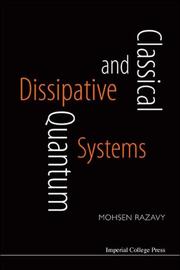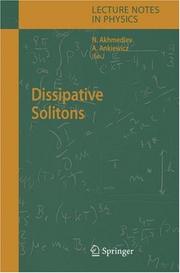| Listing 1 - 10 of 35 | << page >> |
Sort by
|
Book

Year: 2020 Publisher: Frontiers Media SA
Abstract | Keywords | Export | Availability | Bookmark
 Loading...
Loading...Choose an application
- Reference Manager
- EndNote
- RefWorks (Direct export to RefWorks)
This eBook is a collection of articles from a Frontiers Research Topic. Frontiers Research Topics are very popular trademarks of the Frontiers Journals Series: they are collections of at least ten articles, all centered on a particular subject. With their unique mix of varied contributions from Original Research to Review Articles, Frontiers Research Topics unify the most influential researchers, the latest key findings and historical advances in a hot research area! Find out more on how to host your own Frontiers Research Topic or contribute to one as an author by contacting the Frontiers Editorial Office: frontiersin.org/about/contact

ISBN: 1281867136 9786611867133 1860949185 9781860949180 9781860949180 9781860945250 1860945252 1860945309 Year: 2005 Publisher: London Imperial College
Abstract | Keywords | Export | Availability | Bookmark
 Loading...
Loading...Choose an application
- Reference Manager
- EndNote
- RefWorks (Direct export to RefWorks)
"This book discusses issues associated with the quantum mechanical formulation of dissipative systems. It begins with an introductory review of phenomenological damping forces, and the construction of the Lagrangian and Hamiltonian for the damped motion. It is shown, in addition to these methods, that classical dissipative forces can also be derived from solvable many-body problems. A detailed discussion of these derived forces and their dependence on dynamical variables is also presented. The second part of this book investigates the use of classical formulation in the quantization of dynamical systems under the influence of dissipative forces. The results show that, while a satisfactory solution to the problem cannot be found, different formulations represent different approximations to the complete solution of two interacting systems. The third and final part of the book focuses on the problem of dissipation in interacting quantum mechanical systems, as well as the connection of some of these models to their classical counterparts. A number of important applications, such as the theory of heavy-ion scattering and the motion of a radiating electron, are also discussed."
Energy dissipation. --- Quantum theory. --- Mechanics. --- Classical mechanics --- Newtonian mechanics --- Physics --- Dynamics --- Quantum theory --- Quantum dynamics --- Quantum mechanics --- Quantum physics --- Mechanics --- Thermodynamics --- Degradation, Energy --- Dissipation (Physics) --- Energy degradation --- Energy losses --- Losses, Energy --- Force and energy

ISSN: 17930901 ISBN: 1281378887 9786611378882 9812774297 9789812774293 9781281378880 9812566503 9789812566508 661137888X Year: 2006 Volume: v. 71 Publisher: Hackensack, N.J. World Scientific
Abstract | Keywords | Export | Availability | Bookmark
 Loading...
Loading...Choose an application
- Reference Manager
- EndNote
- RefWorks (Direct export to RefWorks)
Phase transition phenomena arise in a variety of relevant real world situations, such as melting and freezing in a solid-liquid system, evaporation, solid-solid phase transitions in shape memory alloys, combustion, crystal growth, damage in elastic materials, glass formation, phase transitions in polymers, and plasticity. The practical interest of such phenomenology is evident and has deeply influenced the technological development of our society, stimulating intense mathematical research in this area. This book analyzes and approximates some models and related partial differential equation
Phase transformations (Statistical physics) --- Energy dissipation. --- Degradation, Energy --- Dissipation (Physics) --- Energy degradation --- Energy losses --- Losses, Energy --- Force and energy --- Phase changes (Statistical physics) --- Phase transitions (Statistical physics) --- Phase rule and equilibrium --- Statistical physics --- Mathematical models.
Book
ISBN: 3319009567 3319009575 Year: 2014 Publisher: Cham : Springer International Publishing : Imprint: Springer,
Abstract | Keywords | Export | Availability | Bookmark
 Loading...
Loading...Choose an application
- Reference Manager
- EndNote
- RefWorks (Direct export to RefWorks)
This book presents a survey on recent attempts to treat classical regulator design problems in case of an uncertain dynamics. It is shown that source of the uncertainty can be twofold: (i) The system is under the influence of an exogenous disturbance about which one has only incomplete - or none - information. (ii) A portion of the dynamical law is unspecified - due to imperfect modeling. Both cases are described by the state space model in a unified way “Disturbance Attenuation for Uncertain Control Systems” presents a variety of approaches to the design problem in the presence of a (partly) unknown disturbance signal. There is a clear philosophy underlying each approach which can be characterized by either one of the following terms: Adaptive Control, Worst Case Design, Dissipation Inequalities. .
Engineering. --- Systems theory. --- Control. --- Systems Theory, Control. --- Mechanical Engineering --- Engineering & Applied Sciences --- Mechanical Engineering - General --- Construction --- System theory. --- Control engineering. --- Control theory. --- Energy dissipation. --- Dynamics --- Machine theory --- Degradation, Energy --- Dissipation (Physics) --- Energy degradation --- Energy losses --- Losses, Energy --- Force and energy --- Control and Systems Theory. --- Systems, Theory of --- Systems science --- Science --- Control engineering --- Control equipment --- Control theory --- Engineering instruments --- Automation --- Programmable controllers --- Philosophy

ISBN: 3540233733 3540315284 9783540315285 9783540233732 Year: 2005 Volume: 661 Publisher: Berlin, Heidelberg : Springer Berlin Heidelberg : Imprint: Springer,
Abstract | Keywords | Export | Availability | Bookmark
 Loading...
Loading...Choose an application
- Reference Manager
- EndNote
- RefWorks (Direct export to RefWorks)
This volume is devoted to the exciting topic of dissipative solitons, i.e. pulses or spatially localised waves in systems exhibiting gain and loss. Examples are laser systems, nonlinear resonators and optical transmission lines. The physical principles and mathematical concepts are explained in a clear and concise way, suitable for students and young researchers. The similarities and differences in the notion of a soliton between dissipative systems and Hamiltonian and integrable systems are discussed, and many examples are given. The contributions are written by the world's leading experts in the field, making it a unique exposition of this emerging topic.
Physics. --- Quantum optics. --- Engineering. --- Optics, Lasers, Photonics, Optical Devices. --- Quantum Optics. --- Engineering, general. --- Solitons. --- Energy dissipation. --- Solitons --- Dissipation d'énergie --- EPUB-LIV-FT LIVCHIMI SPRINGER-B --- Construction --- Industrial arts --- Technology --- Lasers. --- Photonics. --- Optics --- Photons --- Quantum theory --- New optics --- Light amplification by stimulated emission of radiation --- Masers, Optical --- Optical masers --- Light amplifiers --- Light sources --- Optoelectronic devices --- Nonlinear optics --- Optical parametric oscillators
Book
Year: 2020 Publisher: Basel, Switzerland MDPI - Multidisciplinary Digital Publishing Institute
Abstract | Keywords | Export | Availability | Bookmark
 Loading...
Loading...Choose an application
- Reference Manager
- EndNote
- RefWorks (Direct export to RefWorks)
Passive vibration control plays a crucial role in structural engineering. Common solutions include seismic isolation and damping systems with various kinds of devices, such as viscous, viscoelastic, hysteretic, and friction dampers. These strategies have been widely utilized in engineering practice, and their efficacy has been demonstrated in mitigating damage and preventing the collapse of buildings, bridges, and industrial facilities. However, there is a need for more sophisticated analytical and numerical tools to design structures equipped with optimally configured devices. On the other hand, the family of devices and dissipative elements used for structural protection keeps evolving, because of growing performance demands and new progress achieved in materials science and mechanical engineering. This Special Issue collects 13 contributions related to the development and application of passive vibration control strategies for structures, covering both traditional and innovative devices. In particular, the contributions concern experimental and theoretical investigations of high-efficiency dampers and isolation bearings; optimization of conventional and innovative energy dissipation devices; performance-based and probability-based design of damped structures; application of nonlinear dynamics, random vibration theory, and modern control theory to the design of structures with passive energy dissipation systems; and critical discussion of implemented isolation/damping technologies in significant or emblematic engineering projects.
stay cable --- vibration control --- hybrid control --- inertial mass damper --- viscous damper --- passive vibration control --- inerter system --- cable bracing --- parametric study --- optimal design --- tuned mass damper --- inerter --- high-rise buildings --- wind tunnel test --- wind-induced response --- structural control --- synchronous multi-point pressure measurement --- seismic protection --- displacement-dependent damping --- stochastic dynamic analysis --- metal damper --- performance parameter --- cyclic loading test --- hysteretic behavior --- energy dissipation capability --- multi-degree of freedom --- graphical approach --- suspension bridges --- seismic test --- pushover test --- precast concrete structure --- shake table --- Base-Isolated Buildings --- bearing displacement --- STMD --- MTMDs --- d-MTMDs --- incremental dynamic analysis --- earthquake --- energy dissipation --- “double-step” characteristics --- stiffness lifting --- seismic performance --- horizontal connection --- prefabricated shear wall structural systems --- high-tech factory --- lead rubber bearing --- moving crane --- soil structure interaction --- vibration --- wind load --- motion-based design --- uncertainty conditions --- constrained multi-objective optimization --- reliability analysis --- passive structural control --- cable-stayed bridges --- adjacent buildings --- seismic pounding --- energy-dissipation systems --- distributed damping systems --- optimal placement --- multibuilding systems --- hybrid genetic algorithm --- parallel computing --- pounding protection --- seismic isolation --- energy dissipation devices --- negative stiffness device --- damped structures
Book
ISBN: 9783540782179 3540782168 9783540782162 3540782176 Year: 2008 Volume: 751 Publisher: Berlin, Germany : Springer,
Abstract | Keywords | Export | Availability | Bookmark
 Loading...
Loading...Choose an application
- Reference Manager
- EndNote
- RefWorks (Direct export to RefWorks)
The dissipative soliton concept is a fundamental extension of the concept of solitons in conservative and integrable systems. It includes ideas from three major sources, namely standard soliton theory developed since the 1960s, nonlinear dynamics theory, and Prigogine's ideas of systems far from equilibrium. These three sources also correspond to the three component parts of this novel paradigm. This book explains the above principles in detail and gives the reader various examples from optics, biology and medicine. These include laser systems, optical transmission lines, cortical networks, models of muscle contraction, localized vegetation structures and waves in brain tissues.
Solitons --- Energy dissipation --- Dissipation d'énergie --- Quantum Theory --- Biology --- Optics and Photonics --- Nuclear Physics --- Physics --- Engineering --- Biological Science Disciplines --- Natural Science Disciplines --- Technology, Industry, and Agriculture --- Disciplines and Occupations --- Technology, Industry, Agriculture --- Atomic Physics --- Physical Sciences & Mathematics --- Solitons. --- Energy dissipation. --- Dissipation d'énergie --- EPUB-LIV-FT LIVPHYSI SPRINGER-B --- Degradation, Energy --- Dissipation (Physics) --- Energy degradation --- Energy losses --- Losses, Energy --- Pulses, Solitary wave --- Solitary wave pulses --- Wave pulses, Solitary --- Physics. --- Neurobiology. --- Applied mathematics. --- Engineering mathematics. --- Quantum optics. --- Lasers. --- Photonics. --- Laser Technology, Photonics. --- Quantum Optics. --- Applications of Mathematics. --- Force and energy --- Connections (Mathematics) --- Nonlinear theories --- Wave-motion, Theory of --- Mathematics. --- Optics, Lasers, Photonics, Optical Devices. --- Math --- Science --- Neurosciences --- Engineering analysis --- Mathematical analysis --- Optics --- Photons --- Quantum theory --- New optics --- Light amplification by stimulated emission of radiation --- Masers, Optical --- Optical masers --- Light amplifiers --- Light sources --- Optoelectronic devices --- Nonlinear optics --- Optical parametric oscillators --- Mathematics

ISBN: 1280411961 9786610411962 354026566X 3540250506 3642064094 Year: 2005 Publisher: Berlin ; New York : Springer,
Abstract | Keywords | Export | Availability | Bookmark
 Loading...
Loading...Choose an application
- Reference Manager
- EndNote
- RefWorks (Direct export to RefWorks)
Energy Dissipation in Molecular Systems analyzes experimental data on the redistribution and dissipation of energy injected into molecular systems by radiation or charged particles. These processes, competing with such practically important relaxation channels as chemical reaction or stimulated emission (laser action), are the primary focus in this monograph. Among other topics, the book treats vibrational redistribution and electronic relaxation in isolated molecules and the effects of inter-molecular interactions (collisions, complex formation, solvent effects) on the relaxation paths. Primary photo-chemical processes (such as isomerization, proton or hydrogen-atom transfer, electron transfer and ionization) are also treated as particular cases of vibrational or electronic relaxation. Only a basic knowledge of quantum mechanics and spectroscopy is assumed and calculations are kept to a strict minimum, making the book more accessible to students.
Energy dissipation. --- Molecular theory. --- Chemistry, Physical and theoretical --- Matter --- Degradation, Energy --- Dissipation (Physics) --- Energy degradation --- Energy losses --- Losses, Energy --- Force and energy --- Constitution --- Chemistry, Physical organic. --- Engineering. --- Atomic, Molecular, Optical and Plasma Physics. --- Classical and Continuum Physics. --- Physical Chemistry. --- Engineering, general. --- Construction --- Industrial arts --- Technology --- Chemistry, Physical organic --- Chemistry, Organic --- Atoms. --- Physics. --- Continuum physics. --- Physical chemistry. --- Chemistry, Theoretical --- Physical chemistry --- Theoretical chemistry --- Chemistry --- Classical field theory --- Continuum physics --- Physics --- Continuum mechanics --- Natural philosophy --- Philosophy, Natural --- Physical sciences --- Dynamics --- Stereochemistry
Book
ISSN: 21955530 ISBN: 3110268280 9783110268287 3110268299 9783110268294 9783110266481 3110266482 9781306205160 1306205166 Year: 2013 Volume: 4 Publisher: Berlin Boston
Abstract | Keywords | Export | Availability | Bookmark
 Loading...
Loading...Choose an application
- Reference Manager
- EndNote
- RefWorks (Direct export to RefWorks)
This book focuses on the dynamic complexity of neural, genetic networks, and reaction diffusion systems. The author shows that all robust attractors can be realized in dynamics of such systems. In particular, a positive solution of the Ruelle-Takens hypothesis for on chaos existence for large class of reaction-diffusion systems is given. The book considers viability problems for such systems - viability under extreme random perturbations - and discusses an interesting hypothesis of M. Gromov and A. Carbone on biological evolution. There appears a connection with the Kolmogorov complexity theory. As applications, transcription-factors-microRNA networks are considered, patterning in biology, a new approach to estimate the computational power of neural and genetic networks, social and economical networks, and a connection with the hard combinatorial problems.
Mathematical physics. --- Energy dissipation. --- Biophysics. --- Attractors (Mathematics) --- Chaotic behavior in systems. --- Biological physics --- Biology --- Medical sciences --- Physics --- Degradation, Energy --- Dissipation (Physics) --- Energy degradation --- Energy losses --- Losses, Energy --- Force and energy --- Physical mathematics --- Attracting sets (Mathematics) --- Attractors of a dynamical system --- Dynamical system, Attractors of --- Sets, Attracting (Mathematics) --- Differentiable dynamical systems --- Chaos in systems --- Chaos theory --- Chaotic motion in systems --- Dynamics --- Nonlinear theories --- System theory --- Mathematics --- Biological Evolution. --- Dynamic Network Complexity. --- Fluid Dynamic Equation. --- Reaction Diffusion System. --- Viability Problem.
Book
ISBN: 9780691153469 0691153469 9786613379719 1400842662 1283379716 9781400842667 9781283379717 Year: 2011 Publisher: Princeton, NJ
Abstract | Keywords | Export | Availability | Bookmark
 Loading...
Loading...Choose an application
- Reference Manager
- EndNote
- RefWorks (Direct export to RefWorks)
Modern complex large-scale dynamical systems exist in virtually every aspect of science and engineering, and are associated with a wide variety of physical, technological, environmental, and social phenomena, including aerospace, power, communications, and network systems, to name just a few. This book develops a general stability analysis and control design framework for nonlinear large-scale interconnected dynamical systems, and presents the most complete treatment on vector Lyapunov function methods, vector dissipativity theory, and decentralized control architectures. Large-scale dynamical systems are strongly interconnected and consist of interacting subsystems exchanging matter, energy, or information with the environment. The sheer size, or dimensionality, of these systems necessitates decentralized analysis and control system synthesis methods for their analysis and design. Written in a theorem-proof format with examples to illustrate new concepts, this book addresses continuous-time, discrete-time, and hybrid large-scale systems. It develops finite-time stability and finite-time decentralized stabilization, thermodynamic modeling, maximum entropy control, and energy-based decentralized control. This book will interest applied mathematicians, dynamical systems theorists, control theorists, and engineers, and anyone seeking a fundamental and comprehensive understanding of large-scale interconnected dynamical systems and control.
Lyapunov stability --- Energy dissipation --- Dynamics --- Large scale systems --- Information Technology --- General and Others --- Lyapunov stability. --- Energy dissipation. --- Dynamics. --- Large scale systems. --- Systems, Large scale --- Dynamical systems --- Kinetics --- Liapunov stability --- Ljapunov stability --- Degradation, Energy --- Dissipation (Physics) --- Energy degradation --- Energy losses --- Losses, Energy --- Engineering systems --- System analysis --- Mathematics --- Mechanics, Analytic --- Force and energy --- Mechanics --- Physics --- Statics --- Control theory --- Stability --- Clausius-type inequality. --- KalmanЙakubovichАopov conditions. --- KalmanЙakubovichАopov equations. --- KrasovskiiЌaSalle theorem. --- asymptotic stabilizability. --- combustion processes. --- comparison system. --- compartmental dynamical system theory. --- compartmental dynamical system. --- control Lyapunov function. --- control design. --- control signal. --- control vector Lyapunov function. --- convergence. --- coordination control. --- decentralized affine. --- decentralized control. --- decentralized controller. --- decentralized finite-time stabilizer. --- discrete-time dynamical system. --- dissipativity theory. --- dynamical system. --- ectropy. --- energy conservation. --- energy dissipation. --- energy equipartition. --- energy flow. --- entropy. --- feedback control law. --- feedback interconnection stability. --- feedback stabilizer. --- finite-time stability. --- finite-time stabilization. --- gain margin. --- hybrid closed-loop system. --- hybrid decentralized controller. --- hybrid dynamic controller. --- hybrid finite-time stabilizing controller. --- hybrid vector comparison system. --- hybrid vector dissipation inequality. --- impulsive differential equations. --- impulsive dynamical system. --- interconnected dynamical system. --- large-scale dynamical system. --- law of thermodynamics. --- linear energy exchange. --- maximum entropy control. --- multiagent interconnected system. --- multiagent systems. --- multivehicle coordinated motion control. --- nonconservation of ectropy. --- nonconservation of entropy. --- nonlinear dynamical system. --- optimality. --- plant energy. --- scalar Lyapunov function. --- sector margin. --- semistable dissipation matrix. --- stability analysis. --- stability theory. --- stability. --- state space. --- subsystem decomposition. --- subsystem energy. --- thermoacoustic instabilities. --- thermodynamic modeling. --- time-invariant set. --- time-varying set. --- vector Lyapunov function. --- vector available storage. --- vector comparison system. --- vector dissipation inequality. --- vector dissipative system. --- vector dissipativity theory. --- vector dissipativity. --- vector field. --- vector hybrid supply rate. --- vector lossless system. --- vector required supply. --- vector storage function. --- vector supply rate.
| Listing 1 - 10 of 35 | << page >> |
Sort by
|

 Search
Search Feedback
Feedback About UniCat
About UniCat  Help
Help News
News